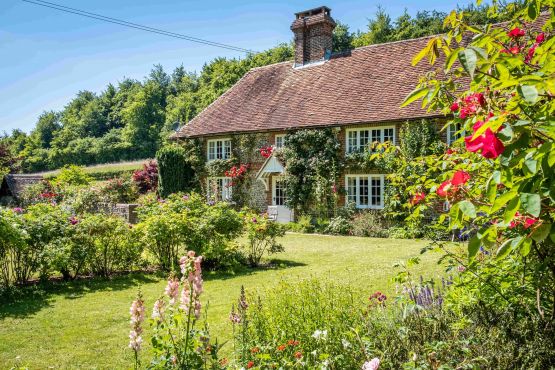
Take 5… Homes with glorious gardens
The saying April showers bring May flowers has certainly rung true this year. Colour now seems to be everywhere which means longer, warmer evenings spent in the garden are nearly upon us.


EPCs. EICRs. NRLs. Becoming a landlord can feel like learning how to speak acronym. But with the right mindset, and tailored advice, it can be time (and money) well-spent. Whether it’s a first buy-to-let or a lived-in family home that’s ready to rent out, our dedicated guide covers the permissions, paperwork and prep that can turn a let into a lucrative investment.
Landlords come in every form. There are the ‘accidental’ ones – those who may have inherited a house or rented their property to cover the mortgage rather than sell – then there are the buy-to-letters – those who are perhaps looking to feather their retirement nest – and finally, there are of course portfolio landlords.
Whatever the situation, at Strutt & Parker, our dedicated lettings team is on hand every step of the way – from advising on rental rates and legislation, to offering seamless management of every size and style of property.
Paperwork is the foundation on which successful lettings are built. For example, if it’s a leasehold property, the first step is to check you have permission to rent it out – under the ‘lease to let’ contract heading – and to see whether there are restrictions to make your future tenant aware of, such as keeping pets.
Meanwhile, residential property owners may need ‘consent to let’ from their mortgage provider. Or it could work in your favour to switch to a landlord-focused buy-to-let mortgage. Meanwhile, a house share may involve arranging a house in multiple occupation (HMO) licence.
Tenants are usually responsible for insuring their own belongings. But landlords need a specialist policy for the building, liabilities and any owned fittings – and some may choose the belt-and-braces rent guarantee insurance as well.
Whatever path you take, there are safety-related must-haves to tick-off too:
A guaranteed monthly income. Fewer comings and goings. Trusted tenants that see your house as their home. There are many plus points to a long-term rental. But shorter contracts bring benefits too – such as having the freedom to flex rental rates to follow the ups (and downs) of the market. Before listing a property, decide whether you’re in it for the long- or short haul.
If you’re an NRL – a non-resident landlord (another acronym) whose ‘usual place of abode’ is outside the UK – then you can apply to HMRC for approval to receive your rental income with no tax deducted and they will register you for self-assessment.
Finding the perfect tenant can be a little like matchmaking. And the interviews, property viewings and background checks take time, which is often why landlords turn to us at Strutt & Parker to do much of the work for you. As well as having local market knowledge, we pitch rental rates to secure the ideal tenant for your property and ensure you’re getting the best price possible.
For many, seeking someone dependable with a stable income is crucial. But there are many other details and documents a letting agent can take care of: their ‘Right to Rent’ in the UK, background credit checks, references and (where needed) guarantors.
250+ different laws can affect landlords. An experienced letting agent can help navigate them.
Once the perfect tenant has said “I do”, there’s the government-backed Tenancy Deposit Scheme (TDP) to consider – a protected ‘pot’ that safeguards the tenant’s money ready for its return when they move out – providing they’ve met the terms of the agreement, of course. This is where a Schedule of Condition comes in. Clearly and accurately capturing the state of the property – in words and photographs – at the start and end of the lease can often help a tenant and landlord to part on good terms.
“As well as guiding you through the pre-let process, a property manager is an important way to put space between you and the tenant, which can often help in maintaining a good relationship. We have the difficult conversations for you, as well as handling property visits to ensure everything’s in order – picking up on issues early, either with the house or tenants, can stop any problems snowballing,” says Georgie Cartwright, Director in our Kensington office.
Shampooed carpets. Spruced-up garden. Spare keys. Before listing a property to rent, presentation is everything. And dealing with all those little niggles – from tightening leaking taps to nailing down creaking floorboards – can lead to a smoother tenancy from the outset.
As Georgie Cartwright explains: “Tenants can have very high expectations, and they’re often less willing to live with defects or quirks than people who live in a home they own. We’d typically suggest to ‘blank canvas’ your property before letting it.” Redecorating, de-cluttering and removing highly personal items helps to create a more airy, calm aesthetic – which tends to be favoured by rental hunters. “After all, tenants aren’t able to renovate or make changes to a property, so it absolutely has to look fresh and neutral in order to have broad appeal in the market” adds Georgie.
Tidying up and pruning back any outside space boosts the curb appeal. And it’s remarkable the difference sparkling grout and shower seals can make to a bathroom. A lot like a just-cleaned oven in a kitchen. Storage is often on renters’ must-have lists too, so it’s worth installing fitted cupboards and wardrobes where possible.
Whether it’s your first time letting a property or you’re renting out the family home, there’s lots to navigate when becoming a landlord – all of which is paired, of course, with laws and regulations. Read our energy efficiency guide for landlords here. And for bespoke advice or to book a valuation, speak to our lettings team here. Or read our additional guide to letting a property here.
For more on this and other housing trends, dip into our Housing Futures publication.